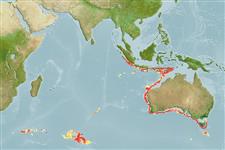Actinopterygii (ray-finned fishes) >
Gadiformes (Cods) >
Macrouridae (Grenadiers or rattails) > Macrourinae
Etymology: Nezumia: A Japanese word that means "mouse" . More on author: Iwamoto.
Environment / Climate / Range
Ecology
Marine; bathydemersal; depth range 500 - 1320 m (Ref. 35909). Deep-water, preferred ?
Eastern Indian Ocean: Western Australia.
Size / Weight / Age
Maturity: Lm ? range ? - ? cm
Max length : 37.0 cm TL male/unsexed; (Ref. 35909)
Short description
Morphology | Morphometrics
Dorsal
spines
(total): 2. Pelvic fin rays 11-12; height first dorsal fin about equal to or more than head length; underside of head scaled, but lacking prominent pores of sensory lateralis system; body scales with dense covering of broadly shield-shaped spinules; 5.5-7.5 scale rows below origin of second dorsal fin, 36-42 lateral line scales over distance equal to predorsal length; trunk completely encircled by broad dark band, although sometimes rather faint; first dorsal fin uniformly blackish; anterior dermal window of light organ scarcely developed, usually apparent only as triangular anterior protrusion of naked periproct, situated behind line connecting insertions of pelvic fins; orbit to preopercle distance 38-44% of head length; upper jaw 29-34%; gill rakers on inner side of first arch 9-10. Snout protruding, angular.
A benthic species found on the continental slope (Ref. 75154).
Life cycle and mating behavior
Maturity | Reproduction | Spawning | Eggs | Fecundity | Larvae
Iwamoto, T. and A. Williams, 1999. Grenadiers (Pisces, Gadiformes) from the continental slope of western and northwestern Australia. Proc. Calif. Acad. Sci. 51(3):105-243. (Ref. 35909)
IUCN Red List Status (Ref. 115185)
CITES (Ref. 94142)
Not Evaluated
Threat to humans
Harmless
Human uses
More information
Common namesSynonymsMetabolismPredatorsEcotoxicologyReproductionMaturitySpawningFecundityEggsEgg development
Age/SizeGrowthLength-weightLength-lengthLength-frequenciesMorphometricsMorphologyLarvaeLarval dynamicsRecruitmentAbundance
ReferencesAquacultureAquaculture profileStrainsGeneticsAllele frequenciesHeritabilityDiseasesProcessingMass conversion
Tools
Special reports
Download XML
Internet sources
